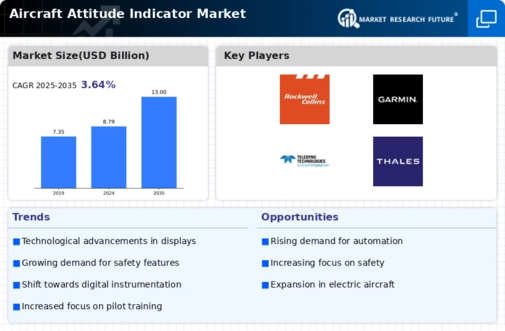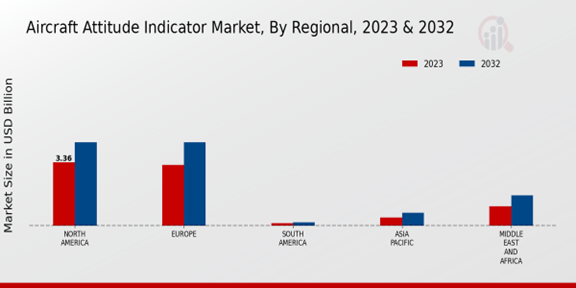Regulatory Compliance
The Global Aircraft Attitude Indicator Market Industry is significantly influenced by stringent regulatory requirements imposed by aviation authorities worldwide. These regulations mandate the use of advanced attitude indicators to ensure flight safety and operational efficiency. For example, the Federal Aviation Administration (FAA) and the European Union Aviation Safety Agency (EASA) have established guidelines that necessitate the adoption of modern avionics systems. Compliance with these regulations not only enhances safety but also drives demand for innovative attitude indicators. As a result, manufacturers are compelled to invest in research and development, thereby contributing to the overall growth of the market.
Emerging Markets Growth
The Global Aircraft Attitude Indicator Market Industry is witnessing growth driven by the expansion of emerging markets, particularly in Asia-Pacific and Latin America. These regions are experiencing rapid economic development, leading to increased investments in aviation infrastructure and fleet modernization. As airlines in these markets expand their operations, there is a growing need for advanced avionics systems, including attitude indicators. The rising middle class in these regions is also contributing to higher air travel demand, further propelling market growth. This trend indicates a promising future for the Global Aircraft Attitude Indicator Market as emerging economies continue to develop their aviation sectors.
Rising Air Travel Demand
The Global Aircraft Attitude Indicator Market Industry is poised for growth due to the increasing demand for air travel globally. As more individuals and businesses opt for air transportation, airlines are expanding their fleets and upgrading their aircraft with advanced avionics systems, including attitude indicators. This trend is particularly evident in emerging markets where economic growth is driving higher passenger numbers. The expansion of low-cost carriers has also contributed to this demand, necessitating the installation of reliable attitude indicators to ensure safety and efficiency. Consequently, the market is expected to witness substantial growth as airlines prioritize modernizing their fleets.
Technological Advancements
The Global Aircraft Attitude Indicator Market Industry is experiencing a surge in technological advancements, particularly with the integration of digital displays and enhanced sensor technologies. These innovations improve accuracy and reliability, which are critical for pilot navigation and safety. For instance, modern attitude indicators now incorporate artificial intelligence to provide real-time data analysis, enhancing situational awareness. As a result, the market is projected to grow from 8.79 USD Billion in 2024 to 13.0 USD Billion by 2035, reflecting a compound annual growth rate of 3.65% from 2025 to 2035. This trend indicates a shift towards more sophisticated avionics systems in the aviation sector.
Military Aviation Expansion
The Global Aircraft Attitude Indicator Market Industry is bolstered by the expansion of military aviation programs across various nations. Governments are increasingly investing in modernizing their military fleets, which includes upgrading avionics systems to enhance operational capabilities. Advanced attitude indicators are essential for military aircraft, providing pilots with critical information for navigation and combat missions. For instance, countries like the United States and India are significantly enhancing their military aviation capabilities, thereby driving demand for sophisticated attitude indicators. This trend suggests a robust growth trajectory for the market as military expenditures continue to rise.
















Leave a Comment